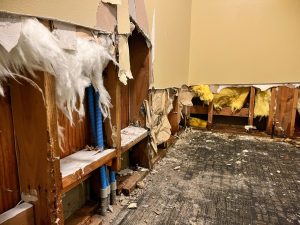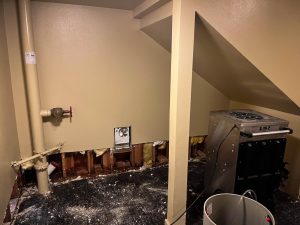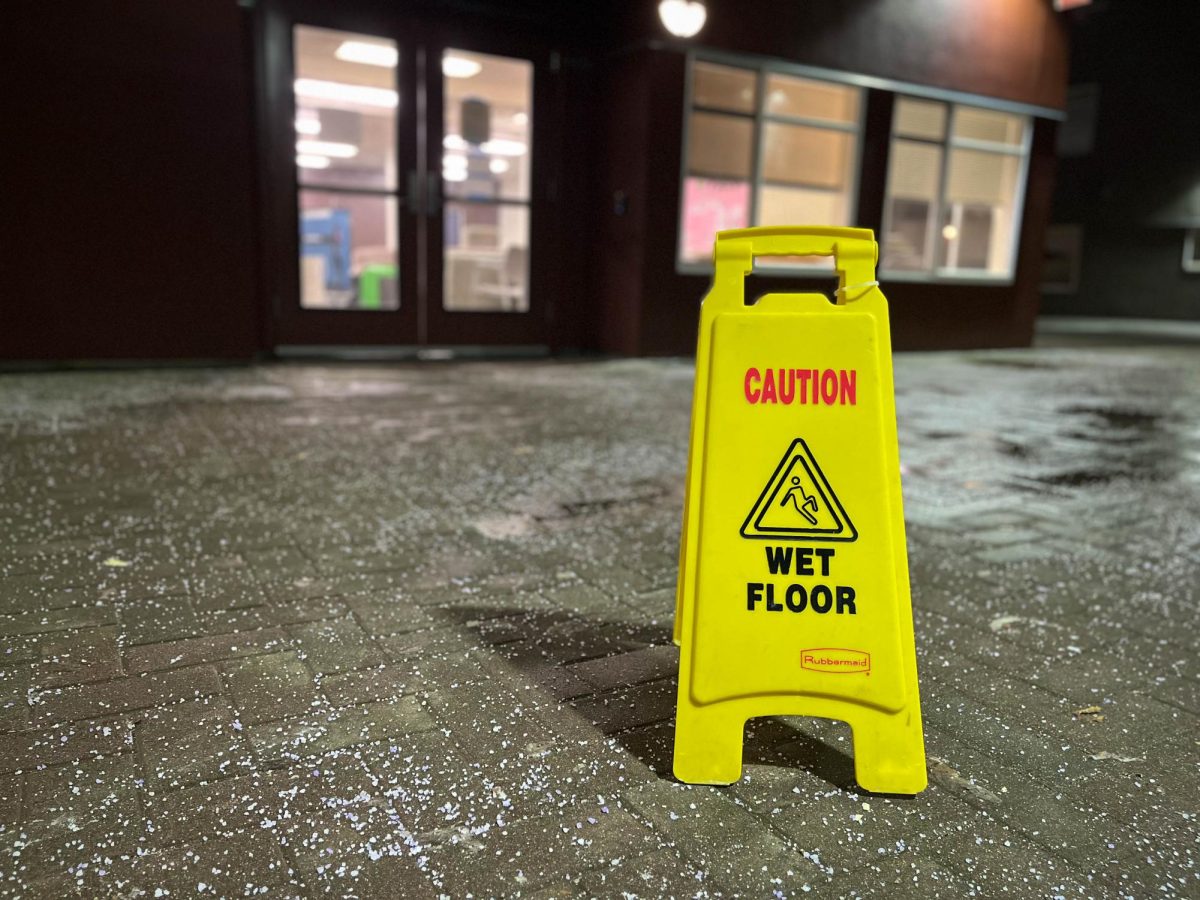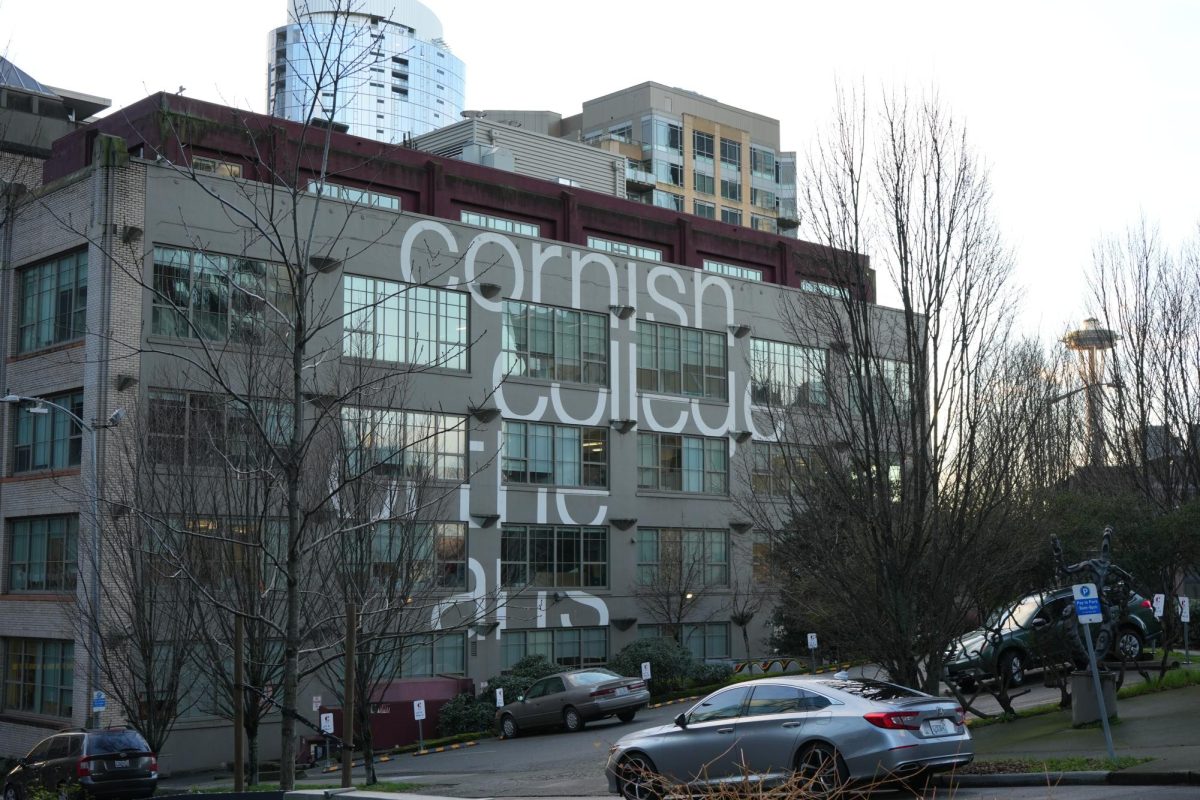You can also listen to this article using the audio player above.
Brown and brackish, videos of gushing water filling up a stairwell in the Murphy Apartments left many viewers shocked Jan. 15. The water, which came from a burst sprinkler pipe, reached a height of 18 inches in the stairwell where the flooding started, and three inches in the rest of the Hopkins building’s first floor. 10 students had to be evacuated from their dorms, while the laundry room and Murphy lounge were shut down.

Currently, Seattle University facilities and maintenance staff are working on drying out the first floor of Hopkins and performing necessary demolition to the affected drywall. Rich Cota, the director of maintenance and operations for facilities, noted that all of the carpet will be replaced while new drywall and insulation will be put in.
“We are looking at drying to be done this week, then other processes can start. In total it will probably be two to three more weeks before the lounge, laundry room and first floor dorms are accessible again,” Cota said.
Cota was thankful that the door to the stairwell was closed, meaning the water could not spread as quickly. The flooding occurred as a direct result of the frigid temperatures that came during the “Seattle Freeze,” the week before Jan. 15. The Murphy Apartments were one of many places across Seattle that were reported to have seen flooding as a result of the cold.
“Seattle fire crews have responded to more than 175 calls for pipe bursts from Friday to Monday, a spokesperson confirmed,” KOMO News reported in an article highlighting the Seattle University flooding.
Rob Schwartz, the associate vice president for facilities and campus services, gave a brief description of what caused the flooding to occur, noting that while the sprinkler heads outside of the buildings were without water and therefore did not freeze, the pipes inside behaved differently.
“When the water froze, it expanded, broke the pipe, and then when the temperature dropped, the flooding started,” Schwartz said.
Despite initial reports that the water may have been sewage, largely due to its dubious appearance in videos spread across social media, Seattle U was quick to shut down those theories.
 “The sprinkler water is discolored because it sits in the pipe until it is activated. The flooding came from the main water line for the building. Another thing that made it look like sewage is that it ran down a wall that had insulation in it, and washed insulation out into the stairwell, making it look brown and like it had ‘floaties’ in it,” Cota clarified.
“The sprinkler water is discolored because it sits in the pipe until it is activated. The flooding came from the main water line for the building. Another thing that made it look like sewage is that it ran down a wall that had insulation in it, and washed insulation out into the stairwell, making it look brown and like it had ‘floaties’ in it,” Cota clarified.
Focusing on those who were directly affected by the flooding, the ten students who were living on the first floor of Hopkins have been moved into emergency housing. Meanwhile, all Murphy residents have been given access to both Campion and Chardin Hall to do their laundry.
Tim Albert, associate director of Housing and Residence Life, said that Seattle U’s first priority was helping students exit the building before assessing where to house those who were, and remain, displaced.
“At the Murphy Apartments, we don’t have a lot of empty rooms sitting around. But, fortunately, there were some recent vacancies and the custodial staff were able to work very efficiently to make the rooms clean and able to be moved into,” Albert said.
Albert went on to clarify that not every student has been granted an exact equivalency to their prior room. In regards to any damage that may have been done to residents’ personal belongings as a result of the flooding, Albert stated that students should be paying for renters insurance in the event that something like this happens.
As of Jan. 19, students have not made any reports to the university about damaged items.
Recounting the events of the day, as well as what followed, Harrison Bissonette, a fourth-year international studies major, who lived in one of the rooms affected by the flooding, is grateful for the job being done by Seattle U.
The flooding started around 10 a.m., when Bissonette woke up to fire alarms going off in the building.
“When I opened the door it was wet on the ground, but there was no standing water yet,” Bissonette recalled.
Upon returning to his room to retrieve bedding later that day, Bissonette saw a watermark on his laundry basket indicating that several inches of water had risen.
“In my room specifically, I luckily didn’t have anything I cared about that got damaged,” Bissonette said.
He was impressed by the school’s quick action, indicating that between the time he evacuated and walked by an hour later, no standing water was visible through the windows outside, and staff were inside clearing out what they could.
Housing called Bissonette later in the day, informing him that he could pick up a temporary card and key to go to a new room. The next day, he was aided in transporting his personal belongings to the emergency room, which he will use as his new apartment for the rest of the school year.

While Bissonette’s potential catastrophe was dealt with effectively, not all flooding that has occurred on campus during the 2023-24 school year has been given the same care and attention.
Eliza Blythe, a second-year environmental studies major, has had to change rooms in Chardin Hall three times this academic year—the most recent as a result of her room flooding on two separate occasions.
“The first time we moved was because our four person suite was too small. Then, what we didn’t know was that the room we were moving into was open because of flooding,” Blythe said.
“Originally, they had informed us that this building is older and so the plumbing is messed up. But what ended up happening is, all of the plumbing was connected and our room was at the end of ten other plumbing systems… so if anyone in another room flushed something other than toilet paper, our room would flood.”
And flood it did: twice. Luckily, each time, either Blythe or one of her roommates were there to help clear things off of the floor. The biggest issue Blythe has with how the situation was handled comes in terms of accountability. To Blythe’s knowledge, there has been no additional work done to address the problems in her prior room, aside from an email to Chardin residents re-emphasizing what can and cannot be flushed down the toilets.
According to Blythe, the responsibility is split between the students who flush unauthorized items down the toilet, as well as the school, for failing to effectively address a plumbing issue allowing multiple floods in the same dorm room in just a few weeks.
Thankfully, according to Schwartz, the recent flooding of the Murphy apartments has shone a light on preventative measures that can be taken.
“Once we got the wall opened up, we saw that there are chances to better seal where the pipe enters the wall as well as the potential to improve insulation,” Schwartz said.
The Murphy Apartments are a great example of older infrastructure… not that any students need a reminder of the dull yellow color they donned just a few years ago.
Kim Thompson, senior director of Disability Services, noted how many of the buildings on campus today are the same ones from when she attended Seattle U in the late 1980s.
“Housing did as thoughtful a job re-rooming people with needs as at any time in my history,” Thompson said.
Despite reportedly efficient responses to the flooding in the Murphy Apartments, Thompson alludes to other issues with the state of facilities at Seattle U. For example, students living in Xavier Hall have complained about the elevator being out of service for months, while other halls like Campion and Bellarmine have faced similar problems.
In regard to elevators on campus, Disabilities Services and the university are there to help find a solution, even if an inelegant one.
“For students with accessibility limitations, it would be great to be able to shut down buildings during the summer to replace some of the faulty systems, but the university is simply not in a financial situation to do so,” Thompson said.
The flooding in the Murphy Apartments offers a valuable opportunity for reflection. According to certain students and staff, the situation, while catastrophic, has been handled effectively and efficiently. Furthermore, the flooding gives the chance for updates and improvements to facilities and accessibility to streamline the student experience.














